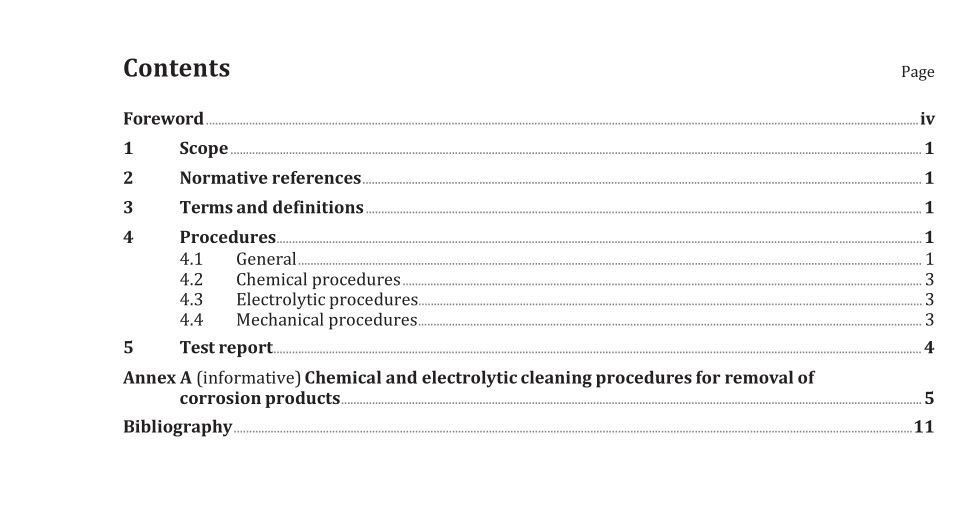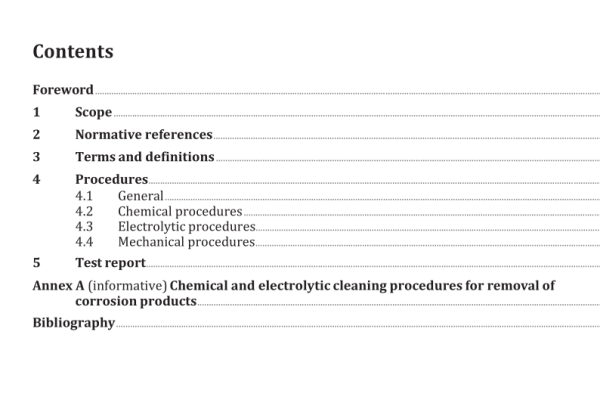ISO 8407:2021 pdf download – Corrosion of metals and alloys — Removal of corrosion products from corrosion test specimens.
4.1.6 The true mass of the specimen, after removal of the corrosion products, will be a value between the masses represented by the points B and D, depending on the degree of protection provided by the corrosion products during the cleaning procedure. 4.1.7 The preferred cleaning method will be one that: a) provides efficient removal of corrosion products; b) provides low or zero mass loss when applied to new uncorroded specimens (see 4.1.4); c) provides a curve of mass as a function of the number of cleaning cycles or time of pickling, which is close to horizontal when the latter is plotted as the abscissa (see 4.1.5 ). 4.1.8 When chemical or electrolytic procedures are used, solutions freshly prepared with distilled or deionized water and reagent grade chemicals shall be used. 4.1.9 After cleaning, the specimen should be thoroughly rinsed with tap water. A light brushing during this procedure will help to remove any remaining surface products resulting from the cleaning process. Finally, the specimens shall be rinsed with distilled or deionized water. The specimen shall then be rinsed thoroughly in ethanol and dried in air. Drying in an air stream is strongly recommended, or optionally a hot air blower or an oven may be used. After drying, the specimens shall be allowed to cool in a dessicator to the balance room temperature before weighing. 4.2 Chemical procedures 4.2.1 Chemical procedures involve the immersion of the corroded test specimen in a chemical solution that is specifically designed to remove the corrosion products with minimal dissolution of any base metal. Several procedures are listed in Annex A (see Table A.1). To facilitate the cleaning, an ultrasonic bath treatment should be used. 4.2.2 Chemical cleaning is often preceded by a light brushing of the test specimen to remove lightly adherent, bulky corrosion products. 4.2.3 Before the chemical treatment, clean the specimens as described in 4.1.1. In connection with the intermittent removal of specimens for weighing, brush the specimens, if necessary, to facilitate the removal of tightly adherent corrosion products. 4.3 Electrolytic procedures Electrolytic cleaning can also be used to remove corrosion products. Several methods of electrolytic cleaning of corrosion test specimens are given in Annex A (see Table A.2). To facilitate the cleaning, an ultrasonic bath treatment should be used. Brushing should follow electrolytic cleaning to remove any loose deposits. This will help to minimize any redeposition of metal from reducible corrosion products in solution that would reduce the measured mass loss. 4.4 Mechanical procedures Mechanical procedures can include scraping, scrubbing, brushing, ultrasonic methods, mechanical shock and impact blasting, e.g. grit blasting, water-jet blasting. These methods are often used to remove heavily encrusted corrosion products. Scrubbing with a bristle brush and a mild abrasive/distilled water slurry can also be used to remove corrosion products.
ISO 8407:2021 pdf download – Corrosion of metals and alloys — Removal of corrosion products from corrosion test specimens






